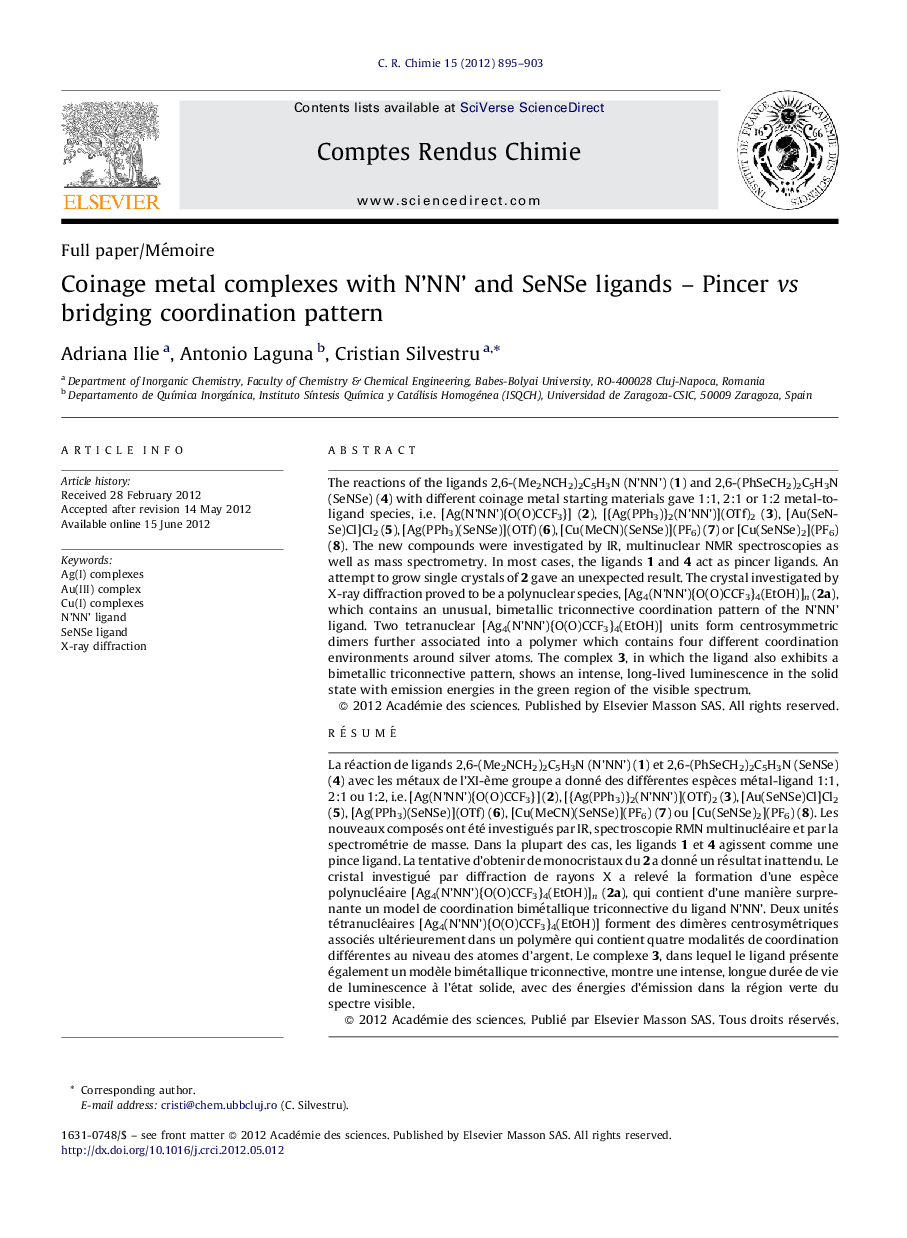| کد مقاله | کد نشریه | سال انتشار | مقاله انگلیسی | نسخه تمام متن |
|---|---|---|---|---|
| 171022 | 458429 | 2012 | 9 صفحه PDF | دانلود رایگان |

The reactions of the ligands 2,6-(Me2NCH2)2C5H3N (N’NN’) (1) and 2,6-(PhSeCH2)2C5H3N (SeNSe) (4) with different coinage metal starting materials gave 1:1, 2:1 or 1:2 metal-to-ligand species, i.e. [Ag(N’NN’){O(O)CCF3}] (2), [{Ag(PPh3)}2(N’NN’)](OTf)2 (3), [Au(SeNSe)Cl]Cl2 (5), [Ag(PPh3)(SeNSe)](OTf) (6), [Cu(MeCN)(SeNSe)](PF6) (7) or [Cu(SeNSe)2](PF6) (8). The new compounds were investigated by IR, multinuclear NMR spectroscopies as well as mass spectrometry. In most cases, the ligands 1 and 4 act as pincer ligands. An attempt to grow single crystals of 2 gave an unexpected result. The crystal investigated by X-ray diffraction proved to be a polynuclear species, [Ag4(N’NN’){O(O)CCF3}4(EtOH)]n (2a), which contains an unusual, bimetallic triconnective coordination pattern of the N’NN’ ligand. Two tetranuclear [Ag4(N’NN’){O(O)CCF3}4(EtOH)] units form centrosymmetric dimers further associated into a polymer which contains four different coordination environments around silver atoms. The complex 3, in which the ligand also exhibits a bimetallic triconnective pattern, shows an intense, long-lived luminescence in the solid state with emission energies in the green region of the visible spectrum.
RésuméLa réaction de ligands 2,6-(Me2NCH2)2C5H3N (N’NN’) (1) et 2,6-(PhSeCH2)2C5H3N (SeNSe) (4) avec les métaux de l’XI-ème groupe a donné des différentes espèces métal-ligand 1:1, 2:1 ou 1:2, i.e. [Ag(N’NN’){O(O)CCF3}] (2), [{Ag(PPh3)}2(N’NN’)](OTf)2 (3), [Au(SeNSe)Cl]Cl2 (5), [Ag(PPh3)(SeNSe)](OTf) (6), [Cu(MeCN)(SeNSe)](PF6) (7) ou [Cu(SeNSe)2](PF6) (8). Les nouveaux composés ont été investigués par IR, spectroscopie RMN multinucléaire et par la spectrométrie de masse. Dans la plupart des cas, les ligands 1 et 4 agissent comme une pince ligand. La tentative d’obtenir de monocristaux du 2 a donné un résultat inattendu. Le cristal investigué par diffraction de rayons X a relevé la formation d’une espèce polynucléaire [Ag4(N’NN’){O(O)CCF3}4(EtOH)]n (2a), qui contient d’une manière surprenante un model de coordination bimétallique triconnective du ligand N’NN’. Deux unités tétranucléaires [Ag4(N’NN’){O(O)CCF3}4(EtOH)] forment des dimères centrosymétriques associés ultérieurement dans un polymère qui contient quatre modalités de coordination différentes au niveau des atomes d’argent. Le complexe 3, dans lequel le ligand présente également un modèle bimétallique triconnective, montre une intense, longue durée de vie de luminescence à l’état solide, avec des énergies d’émission dans la région verte du spectre visible.
Journal: Comptes Rendus Chimie - Volume 15, Issue 10, October 2012, Pages 895–903